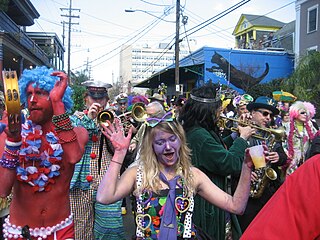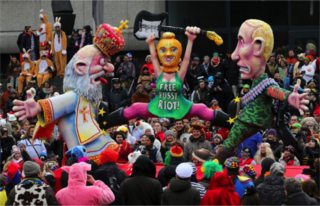
The cap and bells is a type of fool's cap with bells worn by a court fool or jester. [1] The bells were also added to the dangling sleeves and announced the appearance of the jester. [2] [3]

The cap and bells is a type of fool's cap with bells worn by a court fool or jester. [1] The bells were also added to the dangling sleeves and announced the appearance of the jester. [2] [3]
The cap and bells could be in the following forms: [2]
Other forms of fool's cap in England were shaped like a monk's cowl with ass's ears, a high-pointed cap covered with bells, or a round cap with an imposing feather. [4] [ unreliable source? ]

A clown is a person who performs physical comedy and arts in an open-ended fashion, typically while wearing distinct makeup or costuming and reversing folkway-norms. The art of performing as a clown is known as clowning or buffoonery, and the term "clown" may be used synonymously with predecessors like jester, joker, buffoon, fool, or harlequin. Clowns have a diverse tradition with significant variations in costume and performance. The most recognisable clowns are those that commonly perform in the circus, characterized by colorful wigs, red noses, and oversized shoes. However, clowns have also played roles in theater and folklore, like the court jesters of the Middle Ages and the jesters and ritual clowns of various indigenous cultures. Their performances can elicit a range of emotions, from humor and laughter to fear and discomfort, reflecting complex societal and psychological dimensions. Through the centuries, clowns have continued to play significant roles in society, evolving alongside changing cultural norms and artistic expressions.

Mardi Gras is the final day of Carnival ; it thus falls on the day before the beginning of Lent on Ash Wednesday. Mardi Gras is French for "Fat Tuesday", reflecting the practice of the last night of consuming rich, fatty foods in preparation for the Christian fasting season of Lent, during which the consumption of such foods is avoided.

A jester, also known as joker, court jester, or fool, was a member of the household of a nobleman or a monarch employed to entertain guests during royal court. Jesters were also traveling performers who entertained common folk at fairs and town markets, and the discipline continues into the modern day, where jesters perform at historical-themed events.

Motley is the traditional costume of the court jester, the motley fool, or the arlecchino character in commedia dell'arte. The harlequin wears a patchwork of red, green and blue diamonds that is still a fashion motif.

The Court Jester is a 1955 American historical musical comedy film starring Danny Kaye, Glynis Johns, Basil Rathbone, Angela Lansbury and Cecil Parker. The film was written, produced, and directed by Melvin Frank and Norman Panama for distribution by Paramount Pictures. It was released in Technicolor and the VistaVision widescreen format.

Clopin Trouillefou is a fictional character first created in the 1831 novel The Hunchback of Notre-Dame by French author Victor Hugo, and subsequently adapted.

A minstrel was an entertainer, initially in medieval Europe. The term originally described any type of entertainer such as a musician, juggler, acrobat, singer or fool; later, from the sixteenth century, it came to mean a specialist entertainer who sang songs and played musical instruments.

A marotte is a prop stick or sceptre with a carved head on it. Jesters usually used a marotte. The word is borrowed from the French, where it signifies either a fool's (literal) "bauble" or a fad.
Foolscap or fool’s cap may refer to:

The Feast of Fools or Festival of Fools was a feast day on January 1 celebrated by the clergy in Europe during the Middle Ages, initially in Southern France, but later more widely. During the Feast, participants would elect either a false Bishop, false Archbishop, or false Pope. Ecclesiastical ritual would also be parodied, and higher and lower-level clergy would change places. The lack of surviving documents or accounts, as well as changing cultural and religious norms, has considerably obscured the modern understanding of the Feast, which originated in proper liturgical observance, and has more to do with other examples of medieval liturgical drama, though there is some connection with the earlier pagan (Roman) feasts of Saturnalia and Kalends or the later bourgeois in Sotie. Over the course of a week, the ceremonies would be led by different people in positions of power within the church. On December 26, St. Stephen's Day, the deacons led the ceremonies. The sub-priests were in charge on December 27, St. John's Day, the choirboys on December 28, Holy Innocents’ Day, and the sub-deacons on the first of January, the Feast of the Circumcision. There is some disagreement on whether the term Feast of Fools was originally used to refer to the collection of days or specifically the celebrations taking place on the first of January. The word "fool" is used as a synonym for humble, as was common in the 11th century, rather than the modern use that treats it as another term for clown or jester.

Archibald "Archy" Armstrong was a native of Cumberland, and according to tradition first distinguished himself as a sheep thief; afterwards he entered the service of James VI and I as a court jester, with whom he became a favourite.
The Fools Guild is a California based social community that produces total immersion theme parties and other theme events. Members self-identify in some way with The Fool, a role that dates back to medieval times when monarchs and nobles often had their own court jester as part of their household. Fools were more than just comics. The Fool had special permission to be subversive. The Fool could speak the unspeakable, wear the unwearable, and behave in ways that no one else would get away with. The Fools Guild motto is, "In Risu Veritas" – In Laughter There Is Truth.

The Swabian-Alemannic Fastnacht, Fasnacht or Fasnat/Faschnat is the pre-Lenten carnival of Alemannic folklore in Switzerland, southern Germany, Alsace and Vorarlberg.

The Shakespearean fool is a recurring character type in the works of William Shakespeare.
Chicot, real name Jean-Antoine d'Anglerais, was the jester of King Henry III of France and later Henry IV. He was sharp-tongued and very cunning, and spoke with the king without formalities.
A sotie is a short satirical play common in 15th- and 16th-century in France. The word comes from the sots, "fools", who appeared as characters in the play. In the plays, these fools would make observations and exchange thoughts on contemporary events and individuals. Shorter plays, sometimes referred to as parades, did not necessarily have any plot at all, but relied simply on a detached dialogue. The genre has its origin in the Feast of Fools and other Carnival-related festivities. The purpose of these events was to present a world turned upside-down, in this case with the fools as fonts of wisdom. The fools were dressed in grey robes, and wore a hood with donkey ears.

Jane Foole, also known as Jane The Foole, Jane, The Queen's Fool, "Jeanne le Fol" or "Jane Hir Fole", was an English court fool. She was the fool of queens Catherine Parr and Mary I, and possibly also of Anne Boleyn.

Carnival in the Netherlands is a festival held mainly in the Southern and Eastern regions of the Netherlands with an emphasis on role-reversal and the suspension of social norms, as part of celebrations of Carnival. The feast was assimilated by the Catholic Church, taking elements from ancient pagan spring festivals and is celebrated in the three days preceding the Christian holidays of Ash Wednesday and Lent.

The Fool's Cap Map of the World is an artistic presentation of a world map created by an unknown artist sometime between 1580 and 1590 CE. The engraving takes the form of a court jester with the face replaced by cordiform world map based on the designs of cartographers such as Oronce Finé, Gerardus Mercator, and Abraham Ortelius.